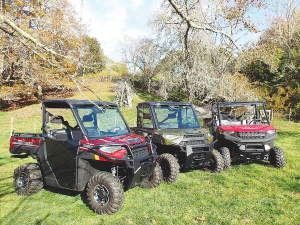Polaris unveils mid-size utility side-by-side
Polaris Off Road has unveiled the 2026 Ranger 500, an all-new mid-size utility side-by-side aimed at bringing the quality and reliability of the American brand into the value segment.
 Polaris’s latest Ranger selection: the Ranger 1000 EPS, the Ranger 1000 HD-EPS and the Ranger Diesel HD-EPS.
Polaris’s latest Ranger selection: the Ranger 1000 EPS, the Ranger 1000 HD-EPS and the Ranger Diesel HD-EPS.
On-farm transport was revolutionised with the arrival of quads, but really came of age with the side-by-side.
Polaris is a pioneer in the former and has carved a name for itself with the latter, particularly with its Ranger series. This model first saw the light around two decades ago, with a concept of making an ATV with seats for a driver and passenger seated side by side.
The first Ranger was a 6x6 – that over the years evolved into 4x4 – along the way picking up more power, better suspension, comfort and more seats.
Rural News recently got the chance to take a closer look at three of Polaris’s flagship models in the shape of Ranger 1000 EPS, the Ranger 1000 HD-EPS and the Ranger Diesel HD-EPS.
All three feature a robust chassis with double A-arm suspension layout at each corner. This offers excellent ground following characteristics, shock absorption and good ground clearance.
The Ranger 1000 EPS is fitted with a SOHC twin-cylinder, fuel injected engine delivering 61hp, that mates to the Polaris PRO-PVT transmission – a variable belt drive layout, with shaft final drives. In use, as the throttle speed is increased, take-up is smooth, while driveability – particularly at low speeds – is easy to control.
Drive selections are controlled via a large, dash-mounted shift lever with High/Low/Neutral/Reverse and Park options. Meanwhile 2WD, 4WD and Turf Mode choices are via a rocker switch, also in a central location.
Trialled in mixed conditions – with flat pasture, rugged bush and soft riverbanks in the mix – the vehicles handled everything with ease, with power delivery smooth, linear and easy to control.
Moving onto the bigger, petrol brother, the Ranger 1000 HD-EPS: While it carries over many of the mechanical functions from the more basic machine, it’s packed with useful extras to make it a standout in this very competitive sector.
For the operator, five inches more cabin room complemented by cushioned seats with adjustable slides, upped the ante in the comfort stakes. Six cup holders, two drinks holders and numerous stowage areas in the dashboard and under the flip-up passenger seats make the HD very practical to live with.
Power is provided by a DOHC 82hp fuel injected unit. This is never wanting in any task and is particularly suited to towing heavy loads, up to 1134kg in difficult terrain. Add in a load bed capacity of 454kg and you can see this vehicle is a workhorse.
A dash-mounted rocker switch offers three engine modes, with Power, Work and Standard on tap. Our test vehicle had the optional farm pack fitted. It includes a windscreen, surely a must-have in performance mode as nailing the throttle certainly makes your eyes water.
Third machine off the rank, the Diesel HD, will certainly find followers in the rural community for its frugal fuel use and removing the need to keep two fuels on farm. Although a little noisier than its petrol-powered cousins, this is no slouch, quickly building revs and topping out at 65km/h.
Power is provided by a 900cc, three-cylinder Kubota engine with mechanical injection that pushes out around 25hp.
A standout during our test drive was the low-down torque that meant shifting heavy loads and tackling inclines was a breeze, while undertaking descents with heavy loads behind was very controlled with good engine braking.
All three models showed excellent retardation on downhill sections, which could be accentuated by using the Active Descent Control Function. This is selected by a rocker switch that made things feel particularly safe. With disc brakes all round, stopping should never be a worry.
At higher speeds, when safe to do so, the driver is helped by a progressive suspension set-up, with difficult terrain handled with ease, aided by the ground clearance of around 28cm.
In summary, if you need to move three people safely around the farm, these three machines certainly warrant a closer look.
Another Australian state has given the green light to virtual fencing, opening another market for Kiwi company Halter.
Farmer interest continues to grow as a Massey University research project to determine the benefits or otherwise of the self-shedding Wiltshire sheep is underway. The project is five years in and has two more years to go. It was done mainly in the light of low wool prices and the cost of shearing. Peter Burke recently went along to the annual field day held Massey's Riverside farm in the Wairarapa.
Applications are now open for the 2026 NZI Rural Women Business Awards, set to be held at Parliament on 23 July.
Ravensdown has announced a collaboration with Kiwi icon, Footrot Flats in an effort to bring humour, heart, and connection to the forefront of the farming sector.
Forest & Bird's Kiwi Conservation Club is inviting New Zealanders of all ages to embrace the outdoors with its Summer Adventure Challenges.
Fonterra has slashed another 50c off its milk price forecast as global milk flows shows no sign of easing.